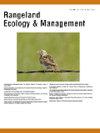气候变化加剧了灌木丛生态完整性的持续下降
IF 2.4
3区 环境科学与生态学
Q2 ECOLOGY
引用次数: 0
摘要
了解气候变化将如何导致灌木丛生态完整性的持续下降对自然资源管理至关重要,但由于与野火和生物入侵的相互作用,这一问题变得更加复杂。我们利用一个基于单个植物的模拟模型,结合对当前灌木丛生态完整性的遥感估计,评估了在一系列情景下灌木丛生态完整性未来可能发生的变化。通过模拟模型,我们可以估计气候变化、野火和入侵的一年生植物如何相互作用,改变影响灌木丛生态完整性的关键植物功能类型(灌木丛、多年生草和一年生草)的潜在丰度。我们的研究结果表明,与鼠茅草生态完整性的提高相比,气候导致的鼠茅草生态完整性的降低可能发生在更广阔的区域。在炎热和干旱地区,鼠尾草生态完整性最有可能降低,而在凉爽和潮湿地区,鼠尾草生态完整性更有可能提高。预计最常见的灌木丛生态完整性等级过渡是从核心灌木丛区到增长机会区,以及从增长机会区到其他牧场区。不同全球气候模型的预测结果差异很大,这凸显了气候不确定性的重要性。不过,我们的预测在目前具有最高的灌木丛生态完整性的地区往往是稳健的。我们的研究结果从长远角度揭示了鼠尾草生态系统对气候变化的脆弱性,并为确定保护和恢复投资的地理优先次序提供了参考。这些结果还表明,气候变化可能会加剧目前存在的威胁,如一年生草类的持续入侵和野火频率的增加,并意味着随着气候变暖,目前保护能力与应对鼠尾草所面临威胁的能力之间的不平衡将会加剧。本文章由计算机程序翻译,如有差异,请以英文原文为准。
Climate Change Amplifies Ongoing Declines in Sagebrush Ecological Integrity
Understanding how climate change will contribute to ongoing declines in sagebrush ecological integrity is critical for informing natural resource management, yet complicated by interactions with wildfire and biological invasions. We assessed potential future changes in sagebrush ecological integrity under a range of scenarios using an individual plant-based simulation model, integrated with remotely sensed estimates of current sagebrush ecological integrity. The simulation model allowed us to estimate how climate change, wildfire, and invasive annuals interact to alter the potential abundance of key plant functional types that influence sagebrush ecological integrity: sagebrush, perennial grasses, and annual grasses. Our results suggest that climate driven reductions in sagebrush ecological integrity may occur over broader areas than increases in sagebrush ecological integrity. Declines in sagebrush ecological integrity were most likely in hot and dry regions while increases were more likely in cool and wet regions. The most common projected transitions of sagebrush ecological integrity classes were declines from Core Sagebrush Area to Growth Opportunity Area and from Growth Opportunity Area to Other Rangeland Area. Responses varied considerably across projections from different global climate models, highlighting the importance of climate uncertainty. However, our projections tended to be robust in areas that currently have the highest sagebrush ecological integrity. Our results provide a long-term perspective on the vulnerability of sagebrush ecosystems to climate change and may inform geographic prioritization of conservation and restoration investments. The results also suggest that ongoing threats, such as the continued invasion by annual grasses and increased wildfire frequency, are likely to be amplified by climate change, and imply that the current imbalance between capacity for conservation to address threats to sagebrush will grow as the climate warms.
求助全文
通过发布文献求助,成功后即可免费获取论文全文。
去求助
来源期刊

Rangeland Ecology & Management
农林科学-环境科学
CiteScore
4.60
自引率
13.00%
发文量
87
审稿时长
12-24 weeks
期刊介绍:
Rangeland Ecology & Management publishes all topics-including ecology, management, socioeconomic and policy-pertaining to global rangelands. The journal''s mission is to inform academics, ecosystem managers and policy makers of science-based information to promote sound rangeland stewardship. Author submissions are published in five manuscript categories: original research papers, high-profile forum topics, concept syntheses, as well as research and technical notes.
Rangelands represent approximately 50% of the Earth''s land area and provision multiple ecosystem services for large human populations. This expansive and diverse land area functions as coupled human-ecological systems. Knowledge of both social and biophysical system components and their interactions represent the foundation for informed rangeland stewardship. Rangeland Ecology & Management uniquely integrates information from multiple system components to address current and pending challenges confronting global rangelands.
 求助内容:
求助内容: 应助结果提醒方式:
应助结果提醒方式:


